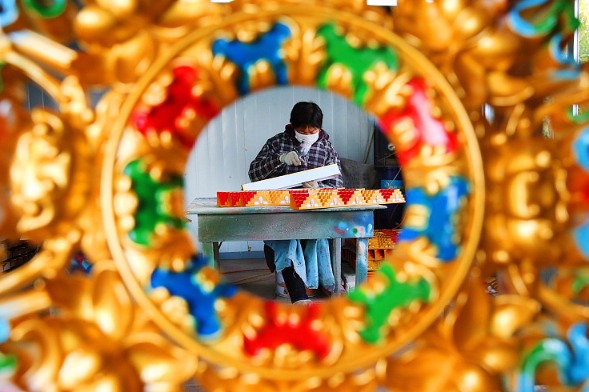Dress code: Smart chitosan
Socks resisting body odor? Shirts that self-clean and keep out the flu? A team of scientists at PolyU tell Wang Yuke about the coming clothing revolution.
There's a revolution coming, changing the clothing we wear, enabling these to combat infections and eliminate odors, predicts Li Li, associate professor of the Institute of Textiles and Clothing at the Hong Kong Polytechnic University (PolyU). It won't be long either before it's on the rack, in fabrics based on chitosan, a property taken from the outer skeletons of insects and crustaceans.
Li and her research team developed a "wet spinning" process to overcome difficulties that had plagued the products evolution as a durable industrial fabric.
The revolutionary change lies in the fact that clothing of the near future will not be just a matter of fashion and comfort. It will also be chosen for its health-giving qualities, even to the point of warding off the flu virus, preventing bacterial infections and speeding up the healing of wounds. That would cover bleeding, burns, bedsore and the kinds of wounds commonly experienced by diabetics.
Chitosan has properties inhibiting bacterial growth. Researchers surmise the material interacts with the DNA of bacterium and presents it from synthesizing protein. It destroys harmful bacteria, reducing the risk of infections. It also inhibits body odor, which results when bacteria consumes protein in sweat, releasing a sulfurous smell. It would mean the end to smelly socks and workout gear, just as a start.
Li is optimistic that chitosan-based fabric will turn into a staple of high fashion because it is elastic, comfortable to wear and pleasing to the touch.
Chitosan has been around for a while. It was marketed as a dietary supplement for weight loss. Those claims have been widely discredited by research. Other reputed beneficial aspects appear promising but are still under study.
Li said she always believed it was a waste anyway to put chitosan fiber into "nutriceutical" and other health care products. It's sold in masks said to carry regenerative and "lifting" functions.
The fibers have also been used in low-end commercial products like bandages and gauze masks, used once and then thrown away. The low tensile strength of the natural fiber makes it impractical as a durable commercial fabric.
Handle with care
That explains the difficulties faced by Li and her team at PolyU. Because the natural fiber is fragile, it would break on the spindle. The loose fibers would wrap around, generating friction and leaving the fibers charged with static electricity - so they were virtually magnetized to the spindle.
Li and her team solved the problem with their wet spinning process. The fibers are dissolved in a bath, rinsed, dried, then the process was repeated. Their "Innovative Spinning System for Chitosan Yarn" earned them a Gold Medal at the 44th International Exhibition of Inventions of Geneva in April.
The team then experimented by blending the chitosan yarn, with top quality cotton from Xinjiang but it didn't work. The combined thickness at 38 mm was too much and the chitosan yarn still broke. They tried thicknesses of 22, 30 and 46 mm. "We found tensile strength deteriorates with increases in the thickness of the chitosan fiber," said Li. Optimal thickness proved to be 30 mm.
Professor Li said the breakthrough means chitosan's application can be further extended into the fashion and textile industries. Even the gauze masks which would fall apart in the laundry will be capable of being laundered and reused. The blended fabric, woven into specific patterns retains its shape. Repeated laundering does not appear to diminish its antibacterial and anti-microbiotic properties.
Clearly, the higher the chitosan fiber content, the greater the antibacterial properties, said Li, but at the cost of durability of the fabric. "It cost us more than a year to find the balance that is able to not only preserve chitosan's antibacterial capabilities but also render the blended yarns strong enough." It turned out that when chitosan fiber comprises 10 percent of the fabric, it is just right.
Li's team also found a solution to the fibers becoming magnetizing to the spindle, by introducing an internal conductive network made of carbon black and carbon nanotubing into the conventional roller. The modified apparatus is highly conductive so that electrons are readily discharged from the fabric. An alternative is to coat the roller with tin foil, to conduct away accumulated electrons, Li added.
Chitosan fiber is expensive, at $50,000 to $100,000 per ton. It's in the same league as cashmere, and about 10 times more costly than cotton or linen. Blending chitosan with cotton for example, produces a much more economical fabric, in addition to its durability, said Li.
Yan Chan, director of Business Development at Hong Kong Research Institute of Textiles and Apparel (HKRITA) told China Daily two companies have purchased licenses for the spinning system. Others have shown interest.
Future apparel
Chitosan-based fabric is only one part of a revolution in attire.
Advanced technology is being researched and applied in textiles and clothing manufacture, said Chan. Design and style are still important to consumers but healthy, odor-free fabrics, their feel and elasticity, are becoming more important to buyers' choices.
Name brands have taken the lead in advancing technological design and manufacturing. Chan cited a number of examples like Nike's Dri-FIT collection. The fabric can remove sweat away from the skin before it evaporates, sparing the wearer the discomfort of wet, sticky clothes. Issey Miyake, a Japanese brand, developed its own A-POC technology (acronym for "A Piece of Cloth"), a manufacturing process that uses computer technology to create clothing from a single piece of thread in one process. Local designers and manufacturers have joined the revolution, Chan emphasizes.
HKRITA has developed a technique called anti-pilling plasma treatment to remove the small balls of fibers that accumulate as clothes are worn and laundered. The development of anti-pilling technique was commissioned by the Peninsula Hotel Group to design and tailor a uniform that was self-cleaning.
Cobe Yip Tak-chi, a graduating student at PolyU's Institute of Textiles and Clothing, who demonstrated her collections of outfits at the annual Knitwear Fashion Show in May, said she heavily employed the inlaid knitting technology in her design. This technique gives her designed knitwear and suits the characteristics of woven fabrics; variation of colors, natural woven shades and dimensional stability, which are lacking in purely knitted fabrics.
Knitting is a more traditional technique where fabrics are produced by arrays of connected loops from a series of yarn in weft and warp. Weaving involves two sets or threads, interlaced. Knitting allows for greater elasticity, but it's limited in its application of different colored yarns, Yip explained.
Students who studied the technique said it provided a big enhancement to their designs.
Yip was inspired by the Whole Garment technology of the Japan-based manufacturing company, Shima Seiki, which can produce knitwear in whole, three dimensional units, free of seams. Typically, knitted garment consist of separate parts - front, back and sleeves - which are sewn together to complete the garment. Using the Whole Garment technology, patterns and designs remain uninterrupted front-to-back, over-the-shoulder, and down-the-sleeves. There are no end pieces to be discarded.
As designers become more environmentally conscious, they are on the lookout for techniques that can reduce waste remnants, and recycle them, Yip remarked, adding that this approach has become popular, particularly among designers on the Chinese mainland. Innovative machineries dedicated to spinning paper into yarn are becoming popular. The technique is still in development, since the yarn is stiffer than wool, and is not suitable for knitwear, she said. Once a new technique emerges, others quickly jump on it and make improvements.
Zhou Jinyun, instructor of the Institute of Textiles and Clothing at PolyU, claims there is greater demand for cutting-edge technology in the clothing industry, particularly in knitwear manufacturing. "The reason we require each student to grasp a new knitting technique is because they cannot compete with the world's fashion designers unless they are already ahead of the latest innovations in technology." He hopes his undergraduates will create something like "Whole Garment" knitwear that already achieved cult status among fashionistas.
Now that conventional fibers no longer satisfy consumers' higher expectations of apparel, new fabrics, like chitosan are leading to the evolution of "smart clothing", which he believes is the key to future fashion.
Contact the writer at jenny@chinadailyhk.com
(China Daily USA 06/24/2016 page5)


















